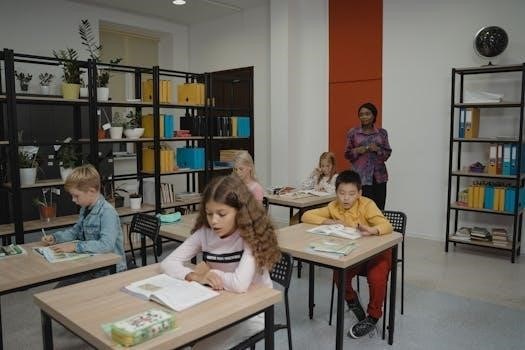
Year 7 Reading Comprehension PDF⁚ A Comprehensive Guide
Welcome to your comprehensive guide to Year 7 reading comprehension! This resource provides insights into how to effectively use PDF worksheets to enhance students’ understanding of written texts. These tools aim to improve skills in a fun and engaging way.

Year 7 reading comprehension introduces students to a more complex level of text analysis and understanding. This stage focuses on enhancing their ability to extract meaning, identify key themes, and critically engage with various types of written material. Worksheets designed for this level often include passages from short stories, informational texts, and excerpts from classic literature, offering a diverse range of reading experiences.
These resources are crafted to boost skills such as identifying main ideas, making inferences, and understanding vocabulary in context. The goal is to develop not just reading fluency, but also analytical thinking, encouraging students to question, interpret, and form their own opinions based on the text. Moreover, Year 7 reading comprehension aims to bridge the gap between basic reading skills and more advanced literary analysis encountered in later years. This foundation is crucial for academic success across all subjects, as comprehension skills underpin learning in every area;
Types of Reading Comprehension Worksheets for Year 7
Year 7 reading comprehension worksheets come in various formats, each designed to target specific skills and learning objectives. One common type features passages followed by multiple-choice questions, which test the student’s ability to recall details, understand vocabulary, and identify the main idea. These are useful for quick assessments and reinforcing basic comprehension.
Another type includes open-ended questions that require students to provide written answers. These promote deeper engagement with the text and encourage critical thinking, as students must formulate their own responses based on their understanding. Fill-in-the-blank exercises are also popular, helping to reinforce vocabulary and understanding of context. Some worksheets focus on specific literary devices, such as similes, metaphors, and personification, while others might involve comparing and contrasting different texts or perspectives. Creative tasks, like writing a summary or creating a different ending to a story, can further enhance engagement and understanding. The variety ensures that different learning styles are catered to and that students develop a well-rounded set of comprehension skills.
Identifying Main Ideas in Year 7 Texts
Identifying the main idea is a crucial skill for Year 7 students, forming the foundation for deeper reading comprehension. Worksheets designed to develop this ability often present passages followed by questions that specifically ask, “What is the main idea of this text?” or “Which sentence best summarizes the passage?”. These questions prompt students to think critically about the overall message and purpose of the writing.
Effective worksheets might also include exercises where students must choose the most appropriate title for a given passage, or write their own brief summary. Another approach involves presenting several statements and asking students to identify which one encapsulates the central theme. Understanding the structure of paragraphs and how supporting details relate to the main point is also essential. Students can practice identifying topic sentences, which often introduce the main idea, and distinguishing them from supporting sentences. By mastering the skill of identifying main ideas, Year 7 students can improve their ability to understand and retain information from various texts, boosting their overall reading comprehension.
Making Inferences in Year 7 Reading

Making inferences is a vital skill for Year 7 students as it enhances their ability to “read between the lines.” Inference worksheets provide passages where the meaning isn’t explicitly stated, requiring students to use clues from the text and their own knowledge to draw conclusions. These worksheets often include questions such as, “What can you infer about the character’s feelings?” or “What is the likely outcome of this situation?”.
Effective worksheets present scenarios that require students to deduce information about characters, settings, and events. Exercises may involve matching inferences to supporting evidence from the text or completing sentences with logical conclusions. Another helpful approach is to provide multiple-choice questions where students must select the most reasonable inference based on the given information. Additionally, students can benefit from activities that ask them to explain their reasoning behind an inference, promoting critical thinking and justification skills. By regularly practicing inference skills, Year 7 students can deepen their understanding of texts, improve their analytical abilities, and become more engaged and thoughtful readers.

Understanding Vocabulary in Context for Year 7
Understanding vocabulary in context is a crucial skill for Year 7 students, enabling them to decipher the meaning of unfamiliar words by examining the surrounding text. Worksheets designed to enhance this skill typically present sentences or passages with target words embedded within them, requiring students to infer the meaning based on contextual clues. These worksheets often include exercises where students match words to their definitions, choose synonyms or antonyms based on context, or rewrite sentences using the correct meaning of the word.
Effective worksheets provide a variety of contextual clues, such as definitions, examples, and contrasts, to aid students in their understanding. Activities may also involve filling in the blanks with appropriate vocabulary words, identifying the word that best fits the context, or explaining how the context helps determine the meaning of the word. Furthermore, students can benefit from exercises that ask them to create their own sentences using the target words, demonstrating their comprehension and ability to apply the words correctly. By practicing vocabulary in context, Year 7 students can expand their word knowledge, improve their reading comprehension, and become more confident and articulate communicators.
Critical Comparison of Texts in Year 7
Critical comparison of texts is a vital skill for Year 7 students, encouraging them to analyze and evaluate different texts to identify similarities, differences, and underlying themes. Worksheets designed to develop this skill often present students with two or more passages that share a common topic or theme, requiring them to compare and contrast various aspects such as the author’s purpose, tone, style, and intended audience. These worksheets may include structured activities where students create Venn diagrams, comparison charts, or written responses outlining the key similarities and differences between the texts.
Effective worksheets prompt students to consider the strengths and weaknesses of each text, evaluate the evidence presented, and form their own informed opinions. Activities may also involve analyzing the use of language, identifying persuasive techniques, and exploring the impact of different perspectives. Furthermore, students can benefit from exercises that ask them to compare and contrast fictional and non-fictional texts, or texts from different genres or time periods. By engaging in critical comparison, Year 7 students can enhance their analytical skills, develop a deeper understanding of literary devices, and become more discerning and thoughtful readers. This process fosters intellectual curiosity and promotes a more nuanced appreciation for the complexities of written communication.
Analyzing Plot and Characters in Year 7 Stories
Analyzing plot and characters is a fundamental aspect of Year 7 reading comprehension, enabling students to delve deeper into narratives and understand how stories unfold; Worksheets focusing on plot often guide students to identify key events, conflicts, turning points, and resolutions within a story. These resources may include exercises such as sequencing events, creating plot diagrams, or summarizing the main plot points. Students learn to recognize how the plot drives the narrative and contributes to the overall meaning of the story.

Character analysis worksheets prompt students to examine the traits, motivations, relationships, and development of characters. Activities may involve describing characters’ physical appearances, personalities, and roles in the story. Students can explore how characters’ actions and decisions influence the plot and themes. Moreover, these worksheets often encourage students to analyze character interactions, identify conflicts, and evaluate how characters change throughout the narrative. By understanding the interplay between plot and characters, Year 7 students can gain a more comprehensive appreciation of literary works and enhance their critical thinking skills. This analysis fosters empathy, improves textual understanding, and encourages deeper engagement with the stories they read, building a solid foundation for future literary studies.
Free Printable Year 7 Reading Comprehension Worksheets
Accessing free printable Year 7 reading comprehension worksheets offers a valuable resource for educators and parents seeking to support students’ literacy development without incurring costs. These worksheets typically cover a diverse range of texts, including excerpts from short stories, informational articles, and poems, tailored to the reading level of Year 7 students. They are designed to enhance comprehension skills, such as identifying main ideas, making inferences, and understanding vocabulary in context. Many of these worksheets also incorporate questions that assess critical thinking and analytical abilities.
Teachers can easily integrate these printable worksheets into their classroom activities, providing students with opportunities to practice and reinforce essential reading skills. Parents can also utilize these resources at home to supplement their child’s learning and provide additional support. The availability of free printable worksheets ensures that all students have access to quality reading materials, regardless of their socioeconomic background. These resources often come in PDF format, making them easy to download, print, and distribute. By using these free worksheets, educators and parents can effectively promote reading comprehension and foster a love of reading among Year 7 students. The convenience and accessibility of these materials make them an indispensable tool for supporting literacy development.
Utilizing Online Resources for Year 7 Reading Comprehension
Online resources offer a wealth of opportunities to enhance Year 7 reading comprehension skills. These resources range from interactive websites to digital libraries, providing students with access to a diverse collection of texts and activities. Many platforms offer engaging exercises, such as multiple-choice questions, fill-in-the-blank activities, and short answer prompts, designed to assess and improve comprehension. Interactive features, like highlighting tools and built-in dictionaries, can further support students’ understanding of the material.
Teachers can leverage these online resources to create dynamic and personalized learning experiences for their students. They can assign online reading passages, track student progress, and provide targeted feedback. Parents can also utilize these resources at home to supplement their child’s learning and foster a love of reading. Online platforms often offer a wide variety of genres and topics, catering to diverse interests and learning styles. Furthermore, many websites provide access to virtual tutors and online communities, where students can collaborate and learn from their peers. By integrating online resources into their reading instruction, educators and parents can effectively promote reading comprehension and prepare Year 7 students for future academic success. The flexibility and accessibility of these resources make them an invaluable tool for supporting literacy development in the digital age.